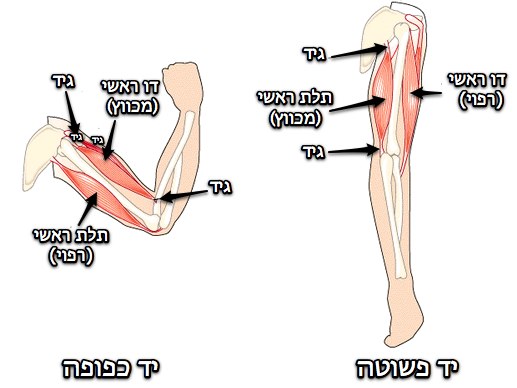הבדלים בין גרסאות בדף "Antagonistic muscles"
(דף חדש: {{LTR}} right|thumb|400px|Arm agonistic and antagonistic muscles '''שרירים אנטגוניסטיים''' ( באנגלית: '''Antagonistic muscles''…) |
|||
| שורה 2: | שורה 2: | ||
[[image: Antagonistic.jpg|right|thumb|400px|Arm agonistic and antagonistic muscles]] | [[image: Antagonistic.jpg|right|thumb|400px|Arm agonistic and antagonistic muscles]] | ||
| − | '''שרירים אנטגוניסטיים | + | '''[[שרירים אנטגוניסטיים]]''' |
| − | |||
| − | |||
| − | |||
| + | Antagonistic muscles are muscles that perform the reverse motion to other muscles (that are called, correspondingly - agonistic muscles). For example, the triceps muscle (the obe that extends the arm at the elbow) is antagonistic to the biceps muscle (that bends the arm). It also works the other way around' that is, the biceps is antaonistic to the triceps. This is obvious from the definition, because the mothion they perform is mutually inverse. | ||
| + | The muscle that bends a joint is called the '''flexor''', and the one that straightens the joint is called the '''extensor'''''. Each flexor-extensor muscle pair is antagonistic to one another. | ||
| + | In training context, we reffer to the muscles that interest us, the one we need to perform well in our spport, as the agonistic muscles. In climbing, the forearm muscles, the ones that flex the fingers, as agonistic, and the ones on the back od the forearm (the ones that straighten the fingers) as antagonistic. | ||
| + | Usually, in climbing, we train the muscles that contron the fingers and give us [[contact strength]] and [[finger strength]]. We seldom train the antagonistic muscles. When training hard, it is highly important to train the antagonistidc muscles too, as failing to do so may result in tone imbalance at the joints, induce tendonitis and make you more prone to injuries in general. | ||
---- | ---- | ||
| − | + | Contributions to this page were made by [[user: Mica Yaniv|Mica Yaniv]] and others...... | |
| − | [[ | + | [[category: rockclimbing]][[category: mountaineering]][[category: sport climbing]][[category: boldering]][[category: training]] |
גרסה אחרונה מ־04:16, 8 בספטמבר 2009
Antagonistic muscles are muscles that perform the reverse motion to other muscles (that are called, correspondingly - agonistic muscles). For example, the triceps muscle (the obe that extends the arm at the elbow) is antagonistic to the biceps muscle (that bends the arm). It also works the other way around' that is, the biceps is antaonistic to the triceps. This is obvious from the definition, because the mothion they perform is mutually inverse.
The muscle that bends a joint is called the flexor, and the one that straightens the joint is called the extensor. Each flexor-extensor muscle pair is antagonistic to one another.
In training context, we reffer to the muscles that interest us, the one we need to perform well in our spport, as the agonistic muscles. In climbing, the forearm muscles, the ones that flex the fingers, as agonistic, and the ones on the back od the forearm (the ones that straighten the fingers) as antagonistic.
Usually, in climbing, we train the muscles that contron the fingers and give us contact strength and finger strength. We seldom train the antagonistic muscles. When training hard, it is highly important to train the antagonistidc muscles too, as failing to do so may result in tone imbalance at the joints, induce tendonitis and make you more prone to injuries in general.
Contributions to this page were made by Mica Yaniv and others......
